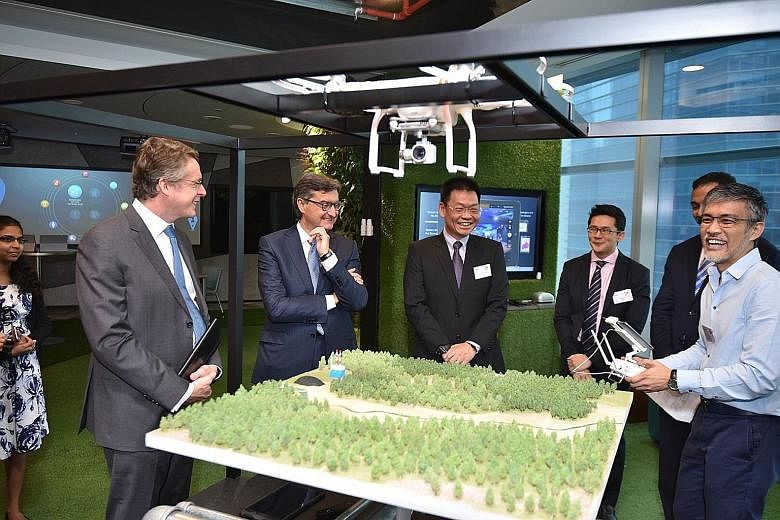Drones, sensors and virtual reality headsets are gearing up to play an important role in the mining, oil and gas, forestry and other natural resource industries.
They can be used for training, key operational matters such as reducing engine or component breakdowns, and boosting productivity.
These high-tech gadgets are part of the rapidly-emerging global industrial Internet of Things (IoT) landscape set to be worth US$14.2 trillion (S$20 trillion) by 2022, says tech consulting firm Accenture.
To harness this technology, Accenture has set up an IoT centre of excellence here, its first in the world.
The centre focuses on using IoT technology for the natural resource industries including mining, oil and gas, forestry and agriculture. The centre, at Marina Bay Financial Centre, was opened yesterday by Economic Development Board (EDB) managing director Yeoh Keat Chuan.
Mr Yeoh said Singapore is already Asia's largest commodity trading hub, conducting key trading, financing and supply chain management activities. The centre will further "deepen the presence of resource companies here by helping them harness IoT capabilities and developing new solutions", he said.
The EDB is supporting the centre in various ways such as introducing new technology partners.
Employing more than 30 data scientists, researchers and engineers, the centre will look at data analytics, cognitive computing, advanced visualisation, drones, telemetry, sensors and related technologies. It also houses an innovation hub of Australian mining giant Rio Tinto.
Accenture group chief executive for growth markets Gianfranco Casati said the centre will help businesses to create new innovations with IoT technologies.
Rio Tinto hopes the centre will bring new insights that will help it increase productivity.
Accenture hopes as many natural resource companies as possible - including Rio's competitors - will collaborate with the centre, said Mr Senthil Ramani, Accenture's managing director, resources industries.
"We aim to create an ecosystem, by working with existing natural resource companies and tech-based firms with new technologies. We want to test, validate and prototype new IoT technologies and business ideas that can be used by the industry," said Mr Ramani, the centre's director.
Various technologies such as drones, wearable and augmented reality as well as virtual reality are demonstrated at the centre.
One demonstration focuses on drones or unmanned aerial vehicles (UAVs) capturing data from remote locations to give real-time insights.
For example, data from a drone which captures images of 100km of an oil pipeline can give insights in just seven minutes, compared to four days for two men inspecting the same length of pipeline on foot.
Mr Ramani said: "This is real benefit to an oil and gas company because this can be translated to savings in time and overheads, and letting the company respond almost immediately to an emergency."
Another area demonstrates the use of wearables and sensors. They can be integrated with plant equipment to improve operational efficiency. A sensor in a water pump, for example, detects that a valve is about to break down. The alert goes to an engineer's smart watch. He can decide to wait for a new valve to arrive or to repair it immediately.
Sensors are equally critical for safety, for example, in a mining conveyor belt carrying different types of metal ore. To prevent accidents, the technology ensures any worker moving too close to the conveyor belt will trigger the sensors which will cause the belt to stop moving.
For training purposes, a virtual reality headset can be used to teach new workers to navigate mining tunnels 1,000m under ground.

